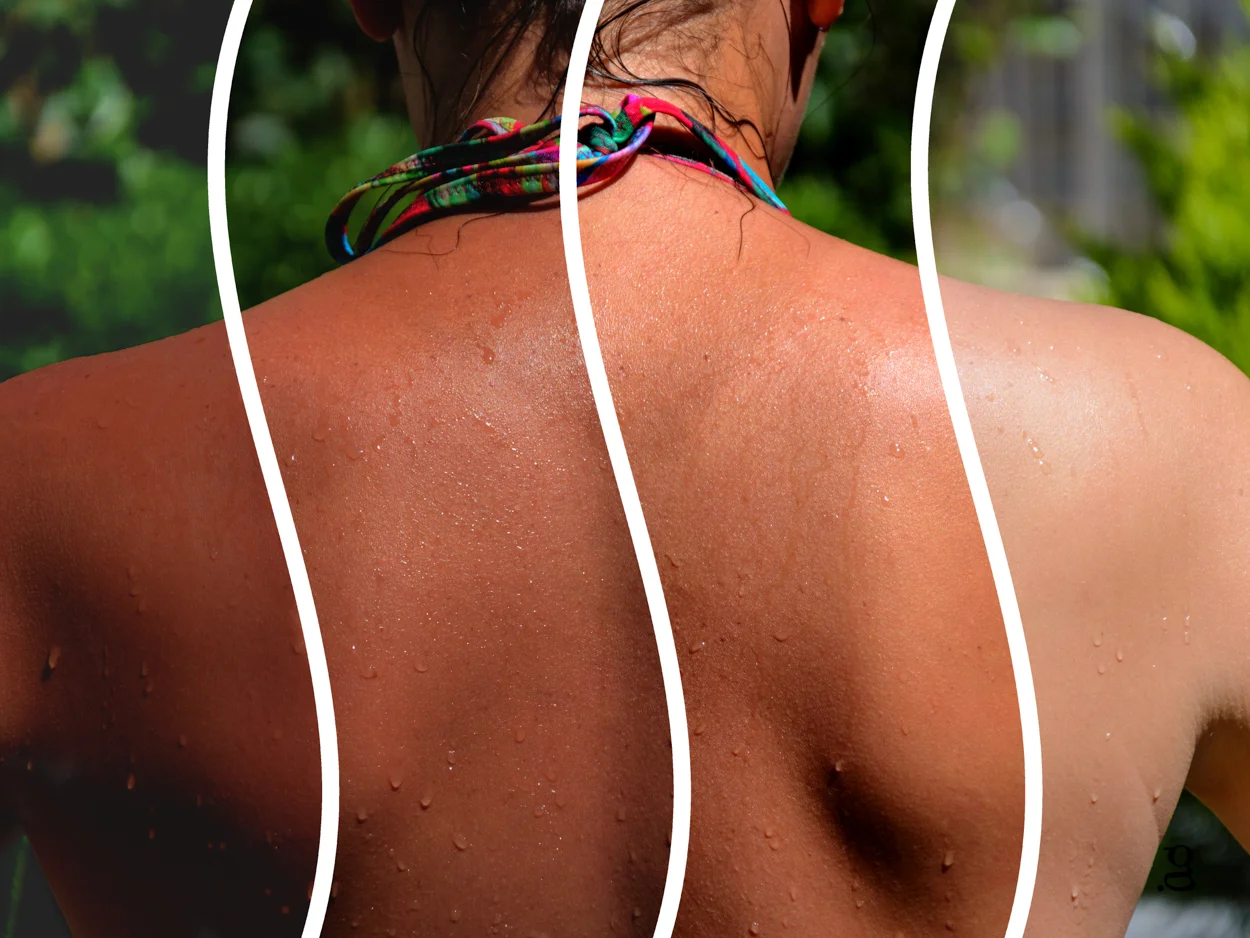Tanning, whether intentional or accidental, can sometimes leave you with a bronzed hue that’s a little too intense for your liking. If you’re finding yourself in this predicament and wondering how to get rid of a tan, look no further. This guide will walk you through various methods to help you gently fade your tan and restore your skin’s natural radiance.
Understanding what a tan is
A tan occurs when your skin is exposed to ultraviolet (UV) radiation, which can come from the sun or artificial sources like tanning beds. Your skin has a natural defense mechanism against this radiation: the production of melanin, the pigment that gives your skin its bronzed look. When exposed to UV rays, your skin cells produce more melanin to shield themselves from damage. This increase in melanin causes your skin to darken, which is what you see as a tan.
Tanning might give you a sun-kissed glow, but it’s essential to know that it’s actually a sign that your skin has been damaged; the extra melanin is your skin’s way of protecting its deeper layers from the harmful effects of UV radiation.
What causes a tan to fade?
A tan fades as a natural part of your skin’s renewal process. Your skin is composed of several layers, with the outermost layer being the epidermis. The epidermis itself has multiple layers, and the one where tanning primarily occurs is called the stratum corneum. This outermost layer consists of dead skin cells that are continuously being shed and replaced by new cells from the layers below.
The process of skin cell turnover is what causes a tan to fade. As the dead skin cells containing excess melanin are shed, they are replaced with new cells that have a more natural pigment level. This gradual shedding and renewal help your skin return to its original tone over time.
Factors that can influence the rate at which a tan fades include:
- Your skin type: Individuals with fairer skin may experience a faster rate of fading as their skin’s melanin production is typically lower.
- The depth of your tan: A deeper tan may take longer to fade than a lighter one, as it involves a more significant increase in melanin production.
- Sun exposure: Continued sun exposure can maintain or deepen your tan while reducing your time in the sun can help your skin return to its natural color more quickly.
How to help a tan fade faster
Keep in mind that, while you may want to expedite the fading process, it’s essential to do so safely and gently to avoid damaging your skin further. Below we’ve listed some of the best methods for helping a tan fade faster.
Method 1: Start exfoliating your whole body, every few days
Out of everything, this is probably the most important and impactful way for getting rid of a tan quickly and safely.
Exfoliation helps get rid of dead skin cells that can cause your skin to look patchy, uneven, and dry. It also helps renew and freshen the skin’s surface, which will help your tan fade away faster than if you naturally just let it fade away.
You can exfoliate your skin in three ways: chemically, physically, or mechanically.
Chemical exfoliation products (aka. cleansers) use active ingredients like AHA and BHA, which help to break down the bonds between dead skin cells so they can be more easily removed.
Physical exfoliation products (aka. scrubs) use formulas with small beads or granules that help to scrub away dead skin cells.
Mechanical exfoliation is a type of physical exfoliation that uses a device, such as a brush or sponge, to help remove dead skin cells from the surface of the skin.
Method 2: Use retinol
Retinol is a popular ingredient in skincare products that, when applied topically, can help to stimulate cell turnover. This means that it helps the skin renew itself more quickly, which can help get rid of a tan faster than letting it fade away naturally.
Also as a bonus, retinol can also help improve the overall appearance of your skin too, so it’s a win-win!
You can find retinol in serums, creams, and lotions, and comes in varying potency (often ranging between 0.01-1%).
It’s important to start slowly with retinol, as it can cause dryness, redness, and irritation if you use too much, too often. Once your skin has adjusted to retinol, you can start using it more frequently.
Just as a side note: do not use retinol directly after exfoliating, or vice versa, as this can cause sensitivity and irritation. Instead, space them out, and do one as part of your daytime routine, and one as part of your nighttime skincare routine.
Method 3: Try a skin-whitening product
While the effectiveness of skin whitening products is limited, there are some products out there you could try – the main ingredient in such products is glutathione, which has some research supporting its usage in skin whitening due to its anti-melanogenic effects (in other words, it helps prevent the formation of melanin, which is the substance in your body that causes pigmentation).
Glutathione-based skin whitening products come in two forms: dietary supplements and topical (usually in the form of a cream or serum) – both versions have studies showing their effectiveness.
Method 4: Try a skin-brightening product
Admittedly these types of products are more geared towards lightening/brightening the complexion as opposed to literally turning your tanned skin back to white, usage of them can make your tan appear reduced.
These products often contain ingredients like vitamin C, azelaic acid, and caffeine, which can help to visually brighten the skin and even out the skin tone.
As with retinol, it’s important to start slowly when using a skin-lightening product, as it can cause dryness, redness,
Method 5: Wear sunscreen daily
This one is more of a preventative measure to help make sure your tan doesn’t get any darker while it naturally starts to fade away.
Sunscreen is extremely beneficial for keeping your skin looking great in general, as it works to physically block out the sun’s harmful UV rays, which are responsible for causing sun damage and pigmentation.
Make sure to choose a sunscreen with an SPF of 30-50, as these offer around 97-98% protection.
Method 6: Remain in the shade; avoid direct sun exposure
This may seem obvious, but if you can, try to stay indoors or in the shade as much as possible. If you have to go out, make sure to cover up. By limiting your direct exposure to UV rays, you’re preventing your body from creating more melanin, thus eventually leading to a paler complexion.
Things to avoid
While it’s all well and good us telling you what to do, here are some of the things you should definitely try to avoid:
Hydroquinone
Hydroquinone is a powerful skin-lightening agent that can be used to treat a variety of conditions, including hyperpigmentation, birthmarks, and melasma.
It’s prescription-only, and should only be used under the supervision of a doctor – hydroquinone should never be used to try to lighten the skin for cosmetic reasons, such as removing a sun tan.
Skin-lightening treatment
Much like hydroquinone, laser skin-lightening treatments are only used to treat skin-darkening disorders like hyperpigmentation – they are not intended for usage in removing sun tans.
Conclusion
Getting rid of a tan safely and effectively requires patience and gentle methods. While a tan may seem desirable, it is actually a sign of skin damage caused by exposure to UV radiation. Exfoliating regularly, using retinol, and trying skin-brightening or skin-whitening products can help expedite the fading process.
It is also essential to wear sunscreen daily and avoid direct sun exposure to prevent further damage. However, it is crucial to avoid using hydroquinone and laser skin-lightening treatments, which are intended for treating skin-darkening disorders rather than removing sun tans.
Remember to prioritize the health and safety of your skin while pursuing a more natural complexion.

